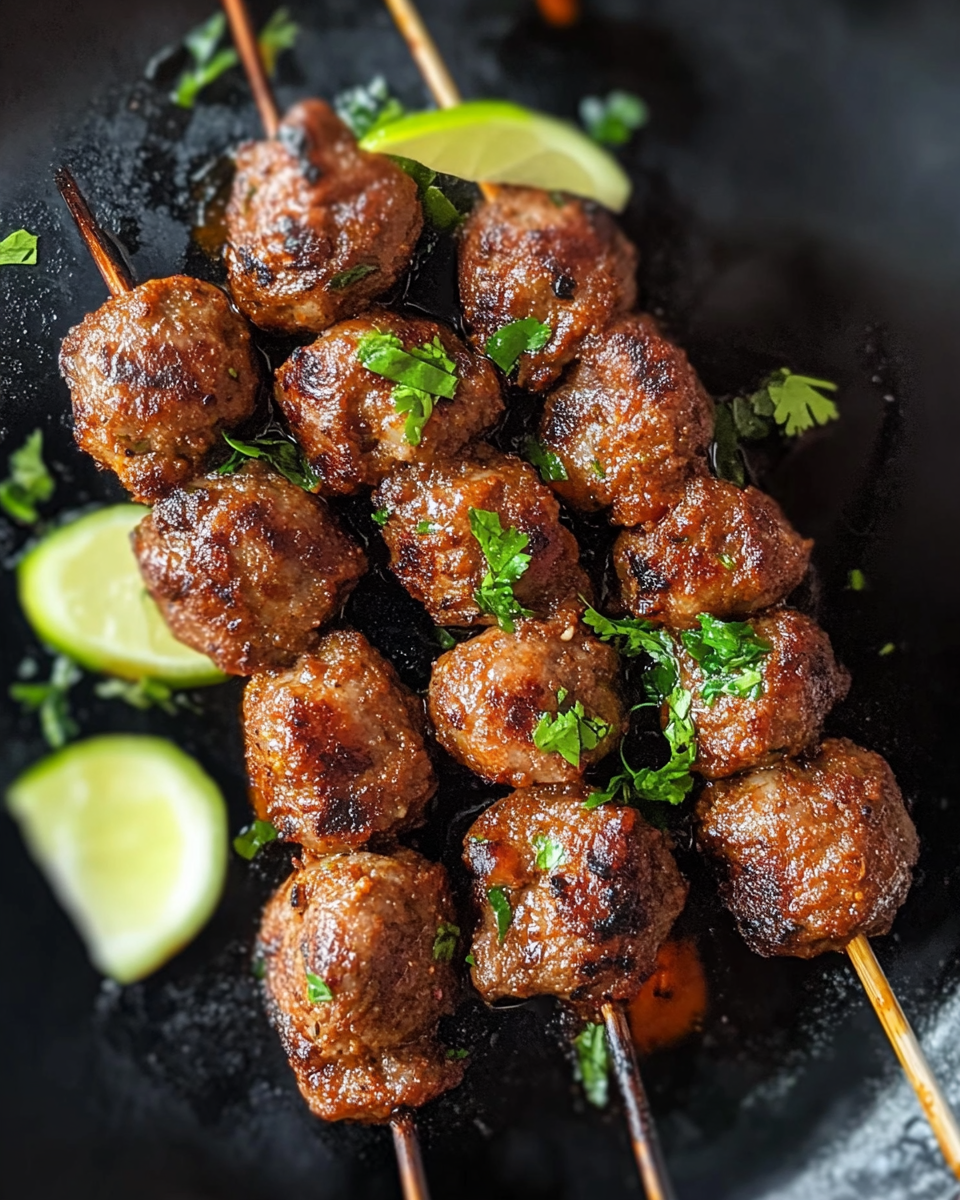Gola Kabab is a cherished delicacy in South Asian cuisine, particularly in Pakistani and Indian households. Known for its melt-in-the-mouth texture and rich, smoky flavor, this kabab is a staple at festive gatherings and special occasions. The name “Gola” refers to its round or oval shape, which distinguishes it from other types of kababs. Traditionally made with minced meat and a blend of aromatic spices, Gola Kabab offers a delightful culinary experience that combines taste, texture, and aroma.
Full Recipe:
Ingredients
- 1 lb ground beef (with at least 20% fat)
- ¾ tbsp ginger paste
- ¾ tbsp garlic paste
- 1.5 tbsp green chili paste (3-6 chilies)
- 1 ¼ tbsp papaya paste (crushed papaya)
- 2 tbsp chopped cilantro/coriander
- ⅓ cup fried onions
- 1 tbsp ghee
- 1 tsp salt
- 1 tsp garam masala
- 1 tsp red chili powder
- 1 tsp coriander powder
- ½ tsp ginger powder
- ¼ tsp turmeric powder
- ⅛ tsp ground mace
- ⅛ tsp ground nutmeg
- ½ tsp allspice (kabab chini)
- A piece of coal for smoke
Directions
- Prepare the Meat Mixture:
Combine all the ingredients in a food processor and blend until well combined. The mixture should be smooth and cohesive. - Test and Adjust:
Shape a small portion of the mixture into a kabab and fry it to test the flavors. Adjust seasoning if necessary. - Smoke Infusion:
Place the meat mixture in a bowl. Heat a piece of coal until red hot. Place a small foil cup or onion peel in the center of the meat mixture, put the hot coal on it, and drizzle a little oil over the coal to produce smoke. Immediately cover the bowl tightly and let it sit for 15 minutes to infuse the smoky flavor. - Shape the Kababs:
Grease your hands and a skewer or straw. Take a portion of the meat mixture and shape it around the skewer to form the traditional Gola Kabab shape. Slide it off the skewer carefully. Repeat with the remaining mixture. - Cooking Options:
- Frying: Heat oil in a pan over medium heat. Fry the kababs for a few minutes on each side until cooked through and golden brown.
- Grilling: Preheat the grill and cook the kababs, turning occasionally, until they are evenly cooked and have a nice char.
- Serving:
Serve the Gola Kababs hot with paratha, naan, or rice, accompanied by green chutney, sliced onions, and lemon wedges.
Nutritional Facts (Per Serving)
- Calories: Approximately 180 kcal
- Protein: 12 g
- Fat: 14 g
- Saturated Fat: 5 g
- Carbohydrates: 2 g
- Fiber: 0.5 g
- Sugar: 0.5 g
- Sodium: 300 mg
Historical and Cultural Significance
The history of Gola Kabab is intertwined with the broader tradition of kababs in South Asia, a region with a rich tapestry of food culture influenced by Persian, Mughal, and indigenous cuisines. Kababs have long been a symbol of celebration, hospitality, and community. The Gola Kabab, in particular, is cherished for its refined texture and complex flavor profile. It is believed to have roots in Mughlai cuisine, which is known for its lavish use of spices, rich meat dishes, and sophisticated cooking techniques. Over time, Gola Kabab has become a staple in Pakistani street food as well as home kitchens, embodying both rustic charm and gourmet appeal. The smoky aroma and melt-in-the-mouth tenderness are hallmarks of the dish that make it unforgettable and often requested at family feasts and weddings.
The Art of Flavor and Texture in Gola Kabab
One of the defining features of Gola Kabab is the meticulous layering of flavors achieved through a combination of fresh ingredients and aromatic spices. The use of ginger, garlic, and green chili paste infuses the meat with pungency and heat, while ground mace, nutmeg, and allspice add warmth and subtle sweetness. The inclusion of fried onions not only imparts depth of flavor but also helps in binding the mixture, contributing to the kabab’s tender texture. A critical step that distinguishes Gola Kabab from many other kababs is the infusion of smoky flavor using hot charcoal, which imparts a unique aroma and complexity that cannot be replicated by other cooking methods. This technique is a signature of many traditional South Asian kababs and showcases the importance of sensory experience in this cuisine.
The texture of Gola Kabab is often described as buttery and smooth, a result of the finely minced meat combined with papaya paste, which acts as a natural tenderizer. This results in kababs that almost melt in the mouth with each bite. Achieving this texture requires skillful blending and balancing of ingredients to ensure the meat is neither too dry nor too oily. The final product is a kabab that holds together well, making it ideal for frying or grilling without falling apart.
Health Aspects and Nutritional Profile
While Gola Kabab is undeniably rich and flavorful, it can also be part of a balanced diet when prepared with quality ingredients and mindful cooking methods. The primary ingredient, ground beef, is an excellent source of high-quality protein, essential for muscle building, tissue repair, and overall body function. The fat content in the beef contributes to the kabab’s moist texture and satiating quality, but it also means that portion control is important for those monitoring their fat intake. The addition of spices such as turmeric, coriander, and garam masala brings antioxidant properties that support immune health and digestion.
On the nutritional front, Gola Kabab provides a good balance of protein and fat with minimal carbohydrates, making it suitable for low-carb and high-protein dietary preferences. It also delivers vital micronutrients such as iron and zinc from the beef, which are crucial for energy metabolism and immune system support. However, the sodium content can be moderate to high depending on added salt and seasoning, so it is advisable for individuals with hypertension or heart conditions to consume it in moderation or adjust seasoning accordingly.
Variations and Adaptations
Like many traditional recipes, Gola Kabab offers flexibility in preparation that allows it to be adapted to different tastes and dietary needs. While beef is the most common meat used, variations with lamb, chicken, or even vegetarian substitutes like soy or lentil-based mixtures exist, each bringing a unique flavor profile and texture. Some recipes incorporate additional herbs like mint or fenugreek leaves for a fresh twist, while others might enhance the spice level with extra green chilies or smoked paprika.
The cooking method also allows for adaptations—though traditionally fried or grilled, Gola Kababs can be baked or cooked in an air fryer for a healthier alternative. The smoky flavor, a hallmark of the dish, can be simulated using smoked spices or liquid smoke if the charcoal method is not feasible. These adaptations make Gola Kabab accessible to a wider audience while preserving the essence of the original recipe.
Serving Suggestions and Pairings
Gola Kabab is best enjoyed fresh and hot, ideally paired with classic accompaniments that balance its rich and spicy flavors. Traditional pairings include naan or paratha breads, which complement the kabab’s texture and help soak up its juices. Freshly sliced onions, lemon wedges, and green chutney made from mint and coriander add brightness and contrast to the savory richness. For a complete meal, it can be served alongside basmati rice or a simple cucumber and tomato salad to provide a refreshing counterpoint.
This kabab also pairs well with yogurt-based side dishes such as raita, which offers a cooling effect and helps mellow the heat from the spices. For special occasions, it can be part of a larger feast including biryani, lentil dishes, and assorted chutneys, creating a diverse and indulgent dining experience. Its versatility makes it suitable for street food-style meals, casual family dinners, or formal celebrations.
Cultural Importance and Social Context
Beyond its culinary qualities, Gola Kabab holds cultural significance as a dish that brings people together. In many South Asian households, preparing kababs is a communal activity involving family members sharing cooking tasks, exchanging stories, and celebrating tradition. The kabab is often a centerpiece at social gatherings, symbolizing hospitality and the joy of sharing food.
In urban centers and street markets, Gola Kababs are popular for their accessibility and robust flavor, representing an intersection of tradition and convenience. The dish bridges generations and social settings, from humble home kitchens to high-end restaurants, showcasing the adaptability and enduring appeal of South Asian cuisine.
Conclusion
Gola Kabab is more than just a delicious meat dish; it embodies the richness of South Asian culinary heritage, combining intricate flavors, traditional cooking techniques, and cultural significance into every bite. Its unique preparation method, including the use of aromatic spices and smoky infusion, creates an unforgettable taste experience that has captivated food lovers for generations.






